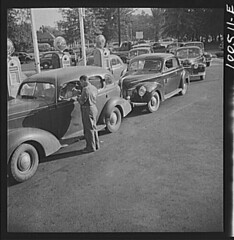Waiting for Gas, 1942
My understanding is that gasoline rationing wasn't really necessary during WWII from the standpoint of gasoline supplies. Remember that back then, the U.S. was the largest producer of oil. But access to rubber for tires was cut off by Japan's taking of Malaysia--so rationing was devised to reduce tire wear.
And I think there was also the thought that it was important to build a sense of shared sacrifice.
A really interesting and quick read is Washington Goes To War by David Brinkley (the former tv newsman). It really communicates how people thought about things back then and the impact on Washington of a huge influx of population. (It would be a good accompaniment to a view of the photos in this digital exhibit.)
I also found interesting the discussion of anti-Roosevelt attitudes by the economic elites. They really hated the development of "big government" and New Deal programs.
It seems as if today's continued attack on big government and social programs, and the constant push to reduce taxes on the wealthy is merely a continuation of the opposition to Roosevelt and the New Deal.




0 Comments:
Post a Comment
<< Home